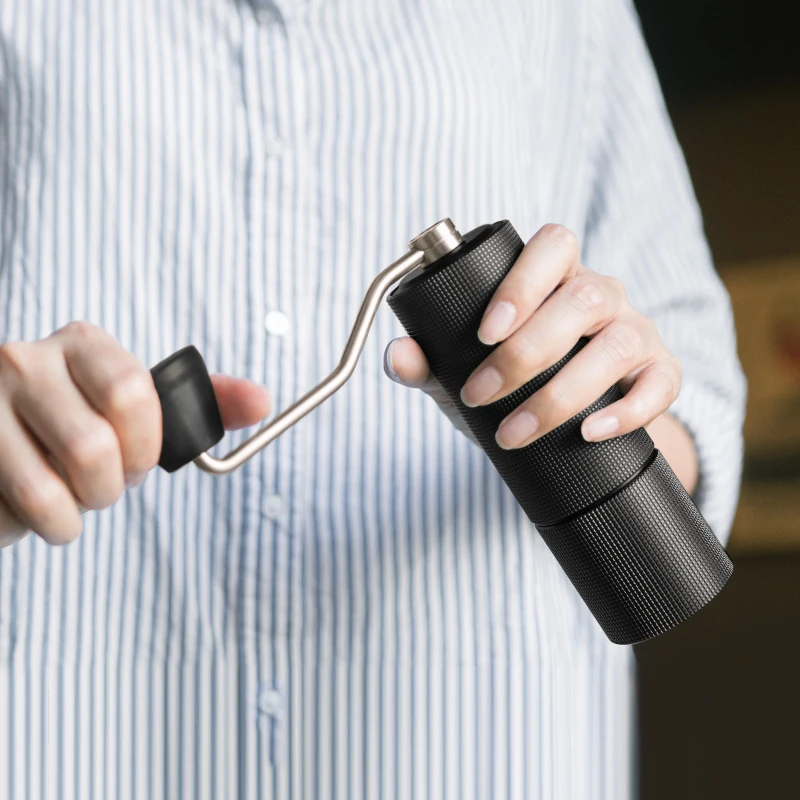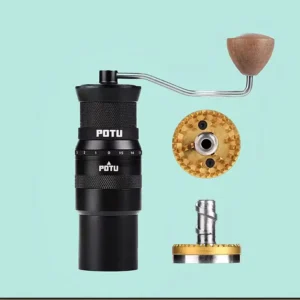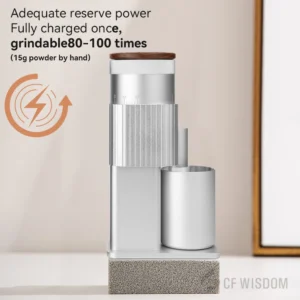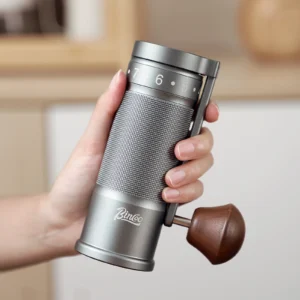Understanding Grind Consistency: The Foundation of Exceptional Coffee
The journey to exceptional coffee begins long before water touches your grounds. At its core lies a fundamental element that many coffee enthusiasts overlook: grind consistency. But what exactly does this mean?
Grind consistency refers to how uniform your coffee particles are after grinding. When you grind coffee beans, you ideally want particles that are all roughly the same size. This uniformity isn’t just about aesthetics—it’s about creating the optimal conditions for flavor extraction.
When examining ground coffee, you’ll typically encounter three types of particles: boulders (larger chunks), fines (powder-like particles), and the uniform particles we actually want. A consistent grind has predominantly uniform particles with minimal boulders and fines.
Why does this matter so much? Coffee extraction is fundamentally a chemical process where water dissolves flavor compounds from coffee grounds. The size of coffee particles directly impacts how quickly and completely this extraction happens. When particles are uniform, water extracts flavors evenly and predictably, resulting in balanced flavor, proper aroma development, full body, and clean finish.
The problem with inconsistent grounds is that they extract at different rates. Smaller particles (fines) over-extract quickly, releasing bitter compounds, while larger chunks (boulders) under-extract, contributing sour, undeveloped flavors. This means your cup simultaneously contains over-extracted and under-extracted coffee—a recipe for disappointing results.
Scientifically speaking, extraction is all about surface area. Smaller particles have more surface area relative to their volume, causing them to extract more quickly than larger particles. When your grinder produces inconsistent particles, this uneven extraction is inevitable.
You can visually identify inconsistent grinds by looking for a mix of powdery dust alongside noticeably larger chunks. But the most telling indicator is in your cup: coffee that somehow tastes both bitter and sour simultaneously is the hallmark of inconsistent grinding.
The difference between consistent and inconsistent grinds is substantial. Well-ground coffee typically achieves extraction percentages between 18-22% (the sweet spot for balanced flavor), while inconsistent grinds might have portions extracting at 13% (under-extracted) and others at 25% (over-extracted).
Understanding additional factors affecting grind consistency provides deeper insight into achieving optimal results.
Every morning, the quality of your coffee experience hinges on this seemingly technical detail. The techniques and solutions we’ll explore in this guide directly impact what ends up in your cup—not just occasionally, but with every single brew.
If you’re serious about elevating your coffee experience, exploring high-quality precision manual grinders designed specifically for consistent grinding is a worthwhile investment.
The Science of Extraction: How Particle Size Uniformity Creates Better Coffee
To truly appreciate why consistency matters, we need to understand what happens when water meets coffee. Coffee extraction isn’t simply dissolving everything at once—it’s a sequential process where different compounds extract at different rates.
When hot water contacts coffee grounds, it begins dissolving soluble compounds in a specific order:
1. Acids and bright fruit notes extract first (fast and easy to extract)
2. Sweetness and balanced flavors follow next
3. Bitter compounds and astringent elements come last (require more time and energy)
This sequential extraction explains why proper extraction percentage is so crucial. Coffee professionals aim for an extraction yield between 18-22% of the coffee’s mass. Within this range, we get the perfect balance of acidity, sweetness, and body without excessive bitterness.
Particle size directly controls this extraction process. Think of water flowing through your coffee grounds like cars on a highway. With consistent particle size, water flows evenly and predictably through the coffee bed, extracting at a uniform rate. But with inconsistent particles, water creates channeling—finding paths of least resistance through the coffee bed. This leads to some areas over-extracting while others barely extract at all.
The science explains why inconsistent grinds produce such disappointing results. When fines (tiny particles) are present, they extract rapidly—sometimes reaching 25-30% extraction levels—contributing harsh, bitter flavors. Meanwhile, larger chunks might only reach 10-15% extraction, adding sour, sharp notes and thin body.
This simultaneous under and over-extraction creates a confusing flavor profile. Your palate detects both the sharp, sour notes of under-extraction (think lemon juice without sugar) alongside the bitter, hollow notes of over-extraction (like burnt toast). No amount of brewing skill can overcome this fundamental inconsistency.
Research demonstrates the direct relationship between grind consistency and extraction quality. Studies show that improving particle uniformity by just 15% can increase flavor compounds in the final cup by 20-25%. The difference isn’t subtle—it’s transformative.
Understanding the relationship between grind consistency and grinding speed can help you achieve better results with your manual grinder.
For those new to coffee exploration, recognizing the stark difference between burr and blade grinders is essential—the former cuts beans with precision while the latter chops randomly, creating wildly inconsistent particles.
The Anatomy of Quality Hand Burr Grinders: What Makes the Difference
Not all hand grinders are created equal. The mechanical design and component quality dramatically impact consistency, and understanding these elements helps you both select and use your grinder properly.
At the heart of every burr grinder lies the burr set—the grinding mechanism that transforms whole beans into ground coffee. Burrs come in two primary geometries:
- Conical burrs: A cone-shaped inner burr fits inside a ring-shaped outer burr, creating a tapering pathway for beans to be progressively crushed into smaller pieces
- Flat burrs: Two parallel discs with cutting surfaces face each other, crushing beans between them
The material of these burrs significantly affects performance:
- Ceramic burrs: Retain sharpness longer but are brittle and can chip if beans contain foreign objects
- Steel burrs: Generally provide more precise cutting, better durability, and superior consistency, especially for espresso
The stability of the grinding mechanism is perhaps the most crucial factor for consistency. This depends on:
- Axle design: The central shaft must be precisely aligned and have minimal play
- Bearing quality: High-quality bearings reduce wobble during grinding
- Burr mounting: How securely the burrs attach to the frame and axle
The adjustment mechanism also plays a vital role in achieving consistency:
- Stepped vs. stepless: Stepped systems offer discrete adjustment points, while stepless provides infinite adjustment
- Calibration system: Quality grinders include ways to maintain consistent zero points
- Thread quality: Fine-pitched, precision-machined threads allow more accurate adjustments
The overall build quality ties everything together:
- Frame rigidity: Prevents flexing during grinding
- Material quality: Metal components generally provide better stability than plastic
- Manufacturing precision: Tighter tolerances mean less play between moving parts
When examining manual coffee burr grinders, you’ll notice significant differences in these components across price points. Premium models feature hardened steel burrs, dual bearings, solid metal construction, and precise adjustment mechanisms—all contributing to superior consistency.
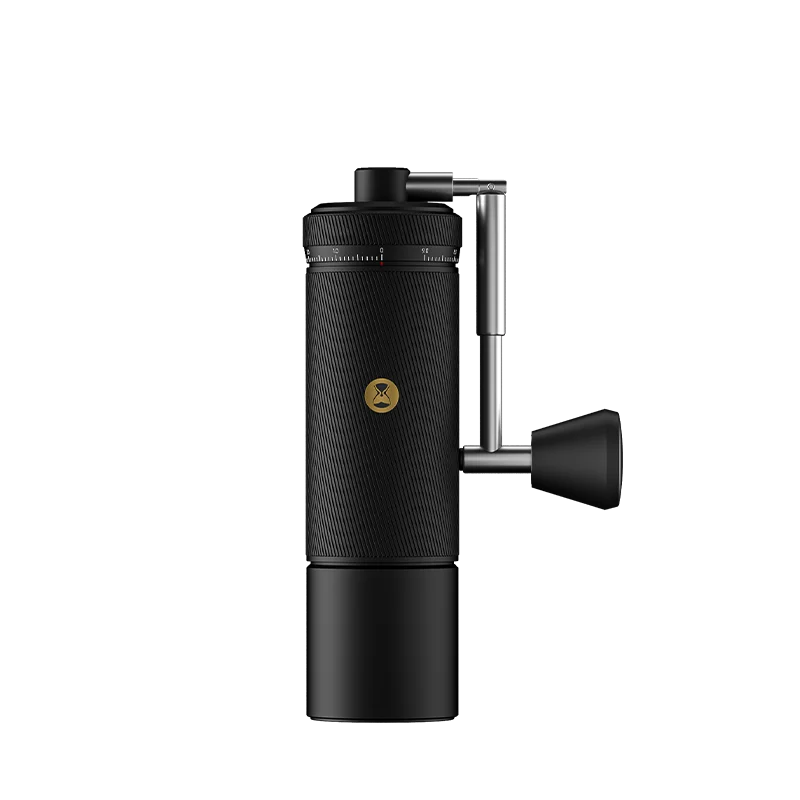
The highest-performing burr sets use geometries specifically designed to minimize fines production. For example, some premium burrs employ cutting angles that shear beans rather than crushing them, producing remarkably uniform particles.
If consistency is your primary concern, exploring various hand burr grinder options with different component qualities can help you find the perfect balance between budget and performance.
Understanding the technical differences between ceramic vs. steel burr coffee grinders can help you make a more informed purchase decision based on your specific needs.
Common Culprits: What Causes Inconsistent Grinds in Hand Burr Grinders
Even quality grinders can produce inconsistent results when certain issues arise. Recognizing these common problems is the first step toward solving them:
Burr-Related Issues
- Misalignment: When burrs don’t perfectly align, they create inconsistent gaps where beans are ground differently
- Poor quality burrs: Lower-grade burrs often have uneven cutting surfaces that produce more fines
- Dull cutting edges: Over time, burrs wear down and lose their ability to cleanly cut beans
- Incompatible burr sets: Some grinders use burr designs better suited for certain grind sizes (espresso vs. French press)
Structural Problems
- Axle wobble: If the central shaft has play or isn’t perfectly straight, the burrs won’t maintain consistent distance
- Bearing wear: Degraded bearings allow lateral movement during grinding
- Adjustment mechanism drift: Some grinders gradually shift from their set position during use
- Frame flexing: Less rigid grinders can flex under grinding pressure, changing the burr alignment
User Technique Issues
- Inconsistent cranking motion: Varying speed or uneven pressure during grinding
- Improper grinder orientation: Holding the grinder at angles rather than vertically
- Inconsistent pressure: Applying different downward force during grinding sessions
- Improper bean loading: Overloading or underloading the grinding chamber
External Factors
- Bean freshness: Older, drier beans produce more fines than fresh beans
- Roast level: Very dark roasts are more brittle and prone to creating fines
- Bean variety: Different coffee varieties have different densities and brittleness
- Environmental humidity: Ambient moisture can affect bean moisture content and grinding dynamics
Understanding the critical impact of burr alignment is essential for consistent results. Even premium grinders can perform poorly when burrs are misaligned by just fractions of a millimeter.
The impact of these issues varies widely. Minor axle wobble might increase fines by 5-10%, while severe burr misalignment can more than double the amount of unusable fine particles. Knowing why coffee grinders produce inconsistent results helps target specific solutions.
Visual indicators can help identify these problems. For example, if you notice coffee building up unevenly around the burr edges, or if certain sections of your grinder show more wear than others, these are telltale signs of alignment issues.
Diagnosing Your Grinder: How to Identify Consistency Problems
Before you can fix consistency issues, you need to identify exactly what’s wrong with your grinder. These practical diagnostic methods will help pinpoint specific problems:
Visual Inspection Method
The simplest assessment is a careful visual examination of your grounds. Place a small amount of ground coffee on a dark, flat surface (like a black sheet of paper). Spread it thin and look for:
- Size variation: Obvious large chunks among otherwise consistent grounds
- Excessive fines: Powdery particles that look noticeably smaller than the majority
- Flakes vs. particles: Properly ground coffee has distinct particles rather than flattened flakes
The Sieve Test
For a more quantitative assessment:
1. Grind a measured amount of coffee at your typical setting
2. Use a fine mesh strainer or sieve to separate particles
3. Weigh the different fractions to calculate the percentage of fines
Quality grinders typically produce less than 15% fines, while problematic ones might create 30% or more.
Burr Alignment Tests
The “marker test” is the gold standard for checking burr alignment:
1. Unplug your grinder and remove the top burr
2. Color the edges of the lower burr with a washable marker
3. Replace the top burr and rotate it gently without beans
4. Remove and examine the top burr—evenly distributed marker transfer indicates good alignment; patchy transfer reveals misalignment
Axle and Bearing Assessment
To check for axle issues:
1. Remove the adjustment mechanism and burrs
2. Hold the central shaft and attempt to move it laterally
3. Any detectable movement indicates bearing wear or axle problems
Zero-Point Calibration Check
To test adjustment consistency:
1. Tighten your grinder until the burrs just touch (zero point)
2. Mark this position and back off to a typical setting
3. Grind some coffee, then return to the zero point
4. If it doesn’t match your mark, the adjustment system is drifting
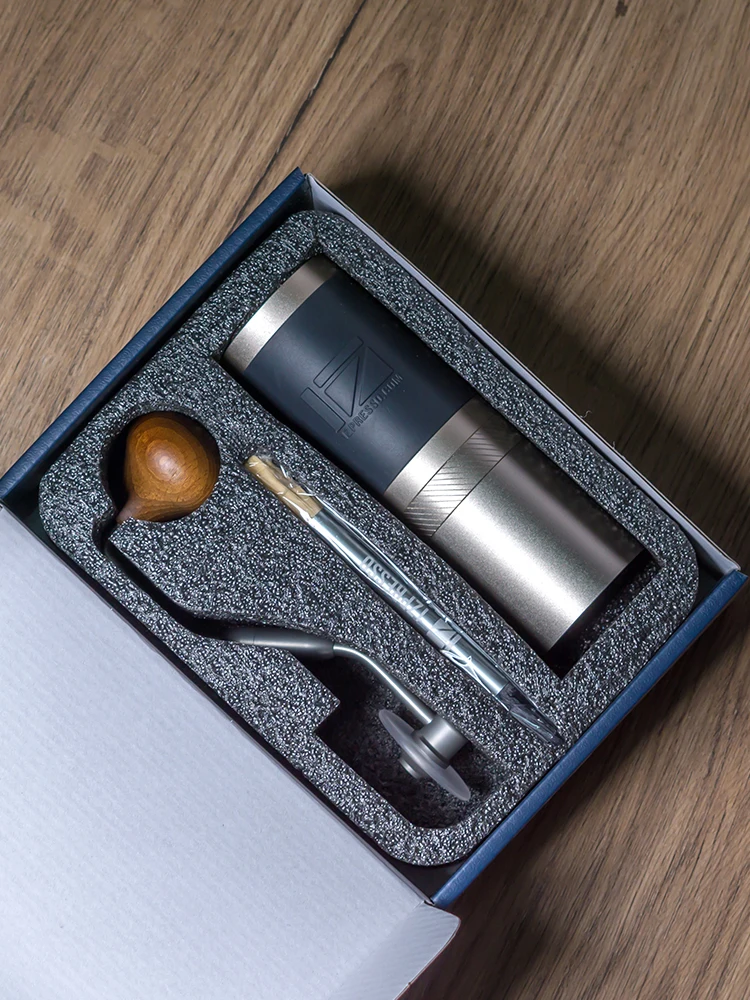
Worn burrs show distinct signs including dull cutting edges, smooth spots on otherwise textured surfaces, and visible chips or deformations. Steel burrs typically need replacement after grinding 500-1000 pounds of coffee, while ceramic burrs may last longer but are more susceptible to sudden damage.
Understanding different burr alignment features can help you identify what might be lacking in your current grinder and what to look for in a replacement.
Maintenance Mastery: Essential Upkeep for Consistent Grinding
Regular maintenance is the most effective way to preserve grind consistency. Follow these procedures to keep your hand grinder performing optimally:
Regular Cleaning Schedule
- After each use: Brush loose grounds from burrs and chambers
- Weekly cleaning: Disassemble and thoroughly clean all ground-touching components
- Monthly deep clean: Complete disassembly and detailed cleaning of all parts
Proper Cleaning Technique
- Disassemble your grinder according to manufacturer instructions
- Remove visible coffee particles with a soft brush
- For steel burrs, use a dry toothbrush or specialized grinder brush
- For ceramic burrs, use slightly dampened Q-tips for stuck particles
- Never immerse burrs or components with bearings in water
- For stubborn oils, use food-safe grinder cleaning tablets or uncooked rice
Addressing Coffee Oils
Coffee oils build up on burrs over time, affecting grind consistency and flavor:
– Consider using grinder-specific cleaning products like Urnex Grindz
– For natural cleaning, grinding a small amount of uncooked rice or bread can absorb oils
– Avoid using water on steel burrs to prevent rust formation
Disassembly and Reassembly
Proper technique prevents damage:
1. Work on a clean, well-lit surface
2. Use a parts tray to organize small components
3. Take photos at each step if you’re unfamiliar with the process
4. Follow reassembly in reverse order
5. Avoid overtightening threaded components
Calibration
Maintaining proper zero hand grinder calibration ensures consistency:
1. Fully clean the burrs and grinding chamber
2. Slowly tighten the adjustment until burrs just begin to touch
3. This is your “zero point”—mark it as reference
4. Set your desired grind size from this consistent starting point
For steel burrs, never use water cleaning. Instead, use a stiff brush and, if necessary, a tiny amount of food-grade alcohol for stubborn residue. Ceramic burrs can tolerate light moisture but should be thoroughly dried before reassembly.
The frequency of deep cleaning depends on usage:
– Light use (1-2 cups daily): Monthly deep clean
– Moderate use (3-5 cups daily): Bi-weekly deep clean
– Heavy use (6+ cups daily): Weekly deep clean
Maintaining manual coffee grinders properly not only preserves consistency but also significantly extends the lifespan of your investment.
Perfect Technique: Mastering the Art of Hand Grinding
Even the finest grinder requires proper technique to deliver consistent results. Master these elements of hand grinding to maximize your grinder’s performance:
Body Mechanics and Stability
The foundation of consistent grinding is stability:
– Stand or sit with good posture, shoulders relaxed
– Hold the grinder vertically—any tilting creates uneven pressure on the burrs
– Brace the grinder against a counter or table for additional stability
– Keep your wrist straight while turning the handle to maintain consistent force
Consistent Motion
The rhythm and force of grinding significantly impacts particle uniformity:
– Maintain a steady, moderate cranking speed (roughly 1-2 revolutions per second)
– Avoid changing speeds dramatically during grinding
– Use smooth, continuous motions rather than jerky turns
– Complete the grinding process without stopping when possible
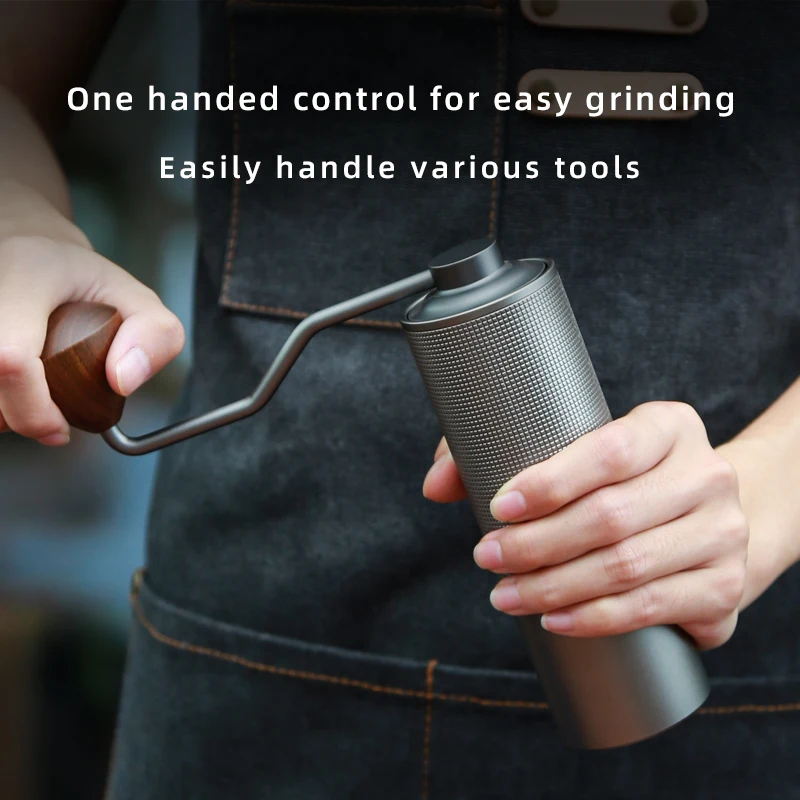
Bean Loading Technique
How you add beans affects how evenly they feed into the burrs:
– Add small, measured amounts rather than filling the hopper completely
– For most precise results, pre-weigh beans before adding to the grinder
– Ensure the hopper is centered above the burrs when adding beans
– Consider single-dosing (grinding only what you need for each brew)
Managing Static Electricity
Static causes fine particles to cling to surfaces and can disrupt distribution:
– The Ross Droplet Technique (RDT): Add a tiny drop of water (just enough to dampen a finger) to beans before grinding
– This minimal moisture eliminates static without affecting the beans
– Alternatively, lightly mist your finger and stir beans before grinding
Adapting for Different Coffees
Different beans require technique adjustments:
– Lighter roasts are denser and harder, requiring more force—maintain slower, more powerful cranking
– Darker roasts are more brittle—use gentler pressure and slightly faster cranking
– Oilier beans may require more frequent cleaning between uses
– Very fresh beans (1-5 days off roast) contain more CO₂ and may require slightly more force
Experienced baristas have found that achieving uniform grind with manual burr grinders often comes down to developing muscle memory through consistent practice.
For optimal results, combine proper technique with appropriate grinder design. Some models require specific handling—hand crank coffee grinders with longer handles generally provide better leverage and stability for more consistent grinding.
Choosing the Right Grinder: Features That Promote Consistency
Selecting the right hand grinder is perhaps the most important decision for achieving consistency. Focus on these key features when making your choice:
Burr Quality and Design
The burrs are the heart of any grinder and the primary determinant of consistency:
– Material: Premium steel burrs generally outperform ceramic for consistency
– Geometry: Look for burrs with precision-cut teeth rather than stamped patterns
– Size: Larger burrs (38mm+) typically produce more consistent particles than smaller ones
– Coating: Some high-end burrs use special coatings like titanium nitride for durability
Bearing System and Axle Stability
The bearing system directly affects consistency by controlling burr alignment:
– Dual bearings: Grinders with bearings at both ends of the axle provide superior stability
– Material quality: Sealed steel bearings outperform plastic bushings
– Axle thickness: Thicker central shafts resist flexing during grinding
– Mounting design: How the axle connects to the frame impacts stability
Adjustment Mechanism
The precision and stability of adjustment determines grind size accuracy:
– Thread pitch: Finer threads allow more precise adjustments
– Click settings: Clearly defined adjustment points help maintain consistency between brews
– Adjustment stability: Mechanisms should maintain settings during grinding without drifting
– Range of adjustment: Wider range accommodates everything from espresso to French press
Overall Build Quality
The grinder’s construction affects everything from alignment to longevity:
– Frame material: All-metal construction provides better stability than plastic components
– Manufacturing precision: Tighter tolerances between parts improve consistency
– Weight and balance: Heavier grinders are generally more stable during use
– Handle design: Longer handles with good grip provide more consistent torque
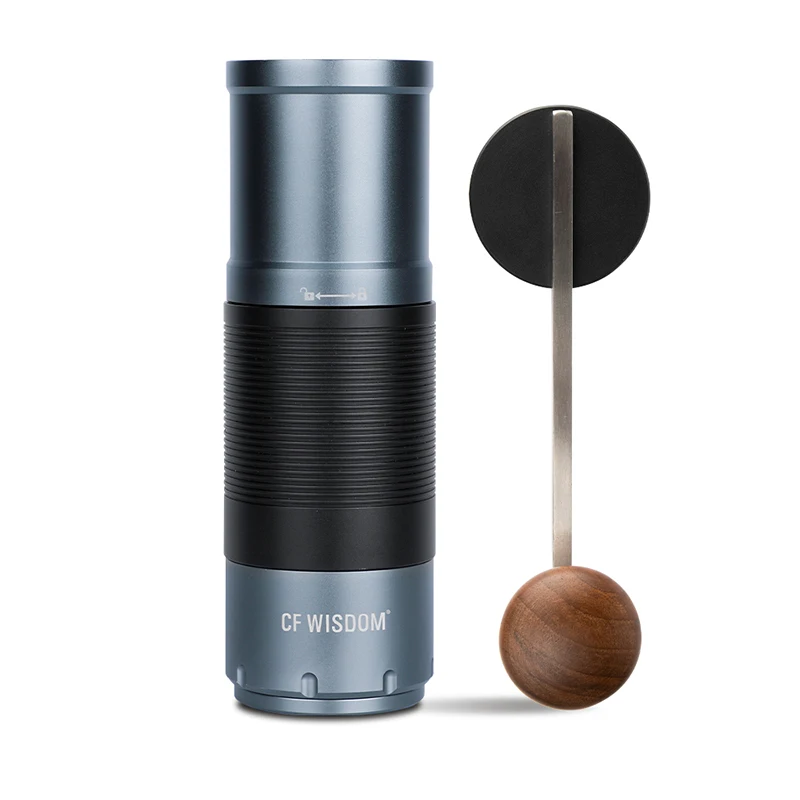
Price-Performance Relationship
While higher prices generally correlate with better consistency, the relationship isn’t linear:
– Entry-level ($25-75): Basic consistency suitable for drip coffee and French press
– Mid-range ($75-150): Good consistency across medium-fine to coarse settings
– Premium ($150-250): Excellent consistency across all grind sizes
– Ultra-premium ($250+): Exceptional consistency approaching commercial electric grinders
The most impactful features for consistency are burr quality, bearing system stability, and frame rigidity—prioritize these elements even if it means sacrificing convenience features.
Exploring fine adjustment hand grinders reveals how precision mechanisms dramatically improve consistency, especially for demanding brewing methods like espresso and pour-over.
For maximum durability and stability, all-metal hand grinders offer superior performance by eliminating flex during grinding.
Top Performers: Hand Grinders Known for Exceptional Consistency
Fine Adjustment Hand Grinder, Precision Manual Grinder, Travel Coffee Grinder
Price range: $185.11 through $494.63 Select options This product has multiple variants. The options may be chosen on the product pageHand Burr Grinder, Hand Crank Coffee Grinder, Manual Espresso Grinder, Portable Coffee Grinder
Price range: $262.72 through $300.22 Select options This product has multiple variants. The options may be chosen on the product pageManual Burr Mill, Manual Coffee Grinder Stainless Steel, Manual Coffee Mill Grinder, Mechanical Coffee Grinder
Price range: $127.26 through $130.32 Select options This product has multiple variants. The options may be chosen on the product pageHand Burr Grinder, Manual Coffee Grinder Stainless Steel, Precision Manual Grinder
Price range: $183.64 through $187.52 Select options This product has multiple variants. The options may be chosen on the product page
Based on extensive testing and user experiences, these hand grinders stand out for their consistency across different price categories:
Entry-Level Consistency Champions ($30-75)
These budget-friendly options provide respectable consistency for casual brewing:
– Qualities: Steel burrs, basic stabilization, decent adjustment mechanisms
– Best for: Drip coffee, French press, and occasional pour-over
– Consistency level: Good for medium to coarse settings; may struggle with espresso
– Value proposition: Significant improvement over blade grinders without major investment
Mid-Range Excellence ($75-150)
These grinders offer impressive consistency that satisfies most brewing methods:
– Qualities: Higher-grade steel burrs, improved bearing systems, more precise adjustment
– Best for: All brewing methods except the most demanding espresso
– Consistency level: Very good across medium-fine to coarse; acceptable for espresso
– Value proposition: The sweet spot for most coffee enthusiasts balancing performance and price
Premium Performers ($150-250)
These high-end hand grinders approach commercial-level consistency:
– Qualities: Precision-made steel burrs, dual bearing systems, rock-solid construction
– Best for: All brewing methods including espresso
– Consistency level: Excellent across all grind settings
– Value proposition: Professional-level results in a portable, manual package
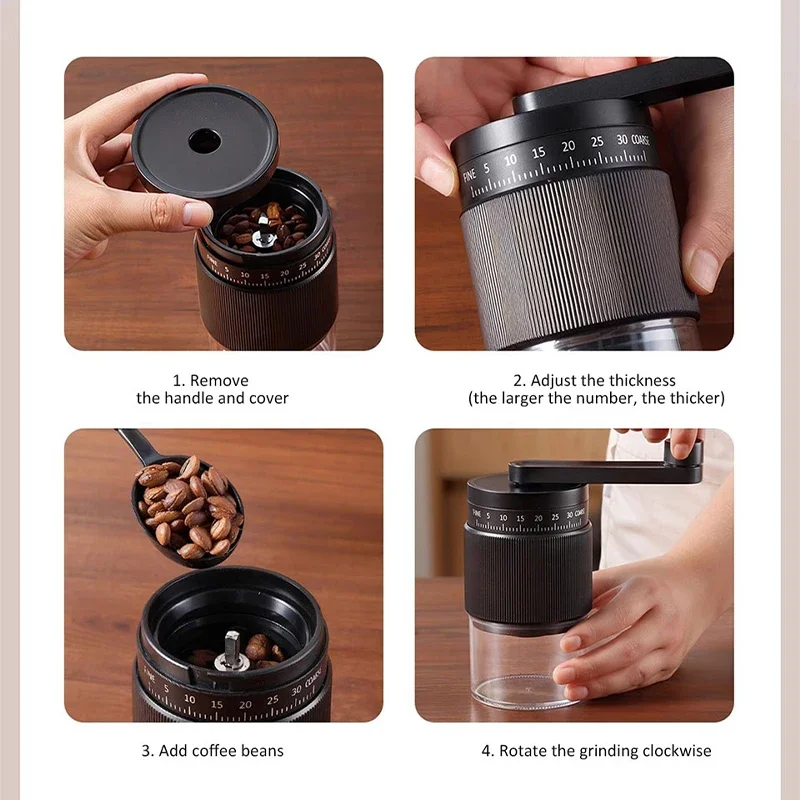
The standout feature among premium grinders is the precision-aligned burr sets, which dramatically reduce fines production even at finer settings. These grinders typically show less than 10% deviation in particle size compared to 20-30% in entry-level models.
For those seeking maximum consistency for espresso specifically, espresso coffee hand grinders feature specialized burr designs optimized for the fine, uniform particles espresso demands.
The definitive guide to hand grinders for consistent coffee offers an even more comprehensive breakdown of top performers across all price ranges.
For those preferring the distinctive cutting characteristics of ceramic burrs, exploring ceramic burr coffee grinders will help you find models that maximize consistency with this material.
Brewing Method Alignment: Matching Grind Size to Your Coffee Maker
Different brewing methods extract coffee under varying conditions, making grind consistency more critical for certain techniques than others:
Espresso: Extreme Consistency Required
- Grind size: Very fine (similar to powdered sugar)
- Particle consistency importance: Critical
- Why it matters: High pressure (9 bars) magnifies any inconsistency, causing channeling
- Impact of inconsistency: Dramatically uneven extraction leading to sour/bitter flavors
- Recommended grinder level: Premium ($150+) for best results
Pour-Over Methods: High Consistency Required
- Grind size: Medium-fine (similar to table salt)
- Particle consistency importance: Very important
- Why it matters: Slow water flow highlights extraction differences between particle sizes
- Impact of inconsistency: Uneven extraction causing muddled flavors
- Recommended grinder level: Mid-range ($75-150) or better
Drip Coffee: Moderate Consistency Required
- Grind size: Medium (between sugar and sand)
- Particle consistency importance: Moderately important
- Why it matters: Machine-controlled flow somewhat mitigates inconsistency issues
- Impact of inconsistency: Noticeable but less dramatic flavor issues
- Recommended grinder level: Entry-level ($30-75) or better
French Press: Lower Consistency Required
- Grind size: Coarse (similar to sea salt)
- Particle consistency importance: Somewhat important
- Why it matters: Long immersion time reduces the impact of particle size variation
- Impact of inconsistency: Mainly affects sediment level rather than flavor
- Recommended grinder level: Entry-level ($30-75) is adequate
Cold Brew: Least Consistency Required
- Grind size: Extra coarse (like breadcrumbs)
- Particle consistency importance: Less critical
- Why it matters: Very long extraction time (12-24 hours) minimizes particle size effects
- Impact of inconsistency: Minimal flavor impact, mainly affects filtration ease
- Recommended grinder level: Basic grinders are sufficient
For brewing methods requiring extremely fine grinds, espresso coffee hand grinders are specifically designed to provide the consistency needed for proper extraction.
Understanding the unique demands of different extraction methods helps explain why consistency matters more for certain brewing styles. The finer the grind size and shorter the extraction time, the more critical consistency becomes.
For those focused on espresso, mastering espresso grind texture and extraction provides deeper insights into the critical relationship between particle consistency and balanced shots.
Does Bean Quality Affect Grind Consistency?
The coffee beans themselves play a surprisingly significant role in grind consistency, even with the best grinders:
Bean Freshness Impact
Fresher beans grind differently than older ones:
– Fresh beans (4-14 days off roast): More moisture content and gases create slight resistance during grinding, often resulting in more consistent particles
– Aged beans (30+ days): Drier and more brittle, these tend to create more fines regardless of grinder quality
– Effect magnitude: Bean freshness can impact fines production by 10-15% even with identical grinder settings
Roast Level Considerations
Different roast profiles affect grinding mechanics:
– Light roasts: Denser and harder, requiring more force to grind. This extra resistance can actually improve consistency in quality grinders but may cause cheaper grinders to flex
– Medium roasts: Generally provide the most consistent grinding results across all grinder types
– Dark roasts: More brittle and oily, these tend to create more fines and can clog grinders more quickly due to oil buildup
Varietal and Processing Method Effects
The coffee’s origin and processing affects its cell structure:
– Dense, high-altitude beans: Typically harder and require more force to grind
– Natural/dry processed coffees: Often more brittle than washed coffees
– Moisture content variations: Affect how beans fracture during grinding
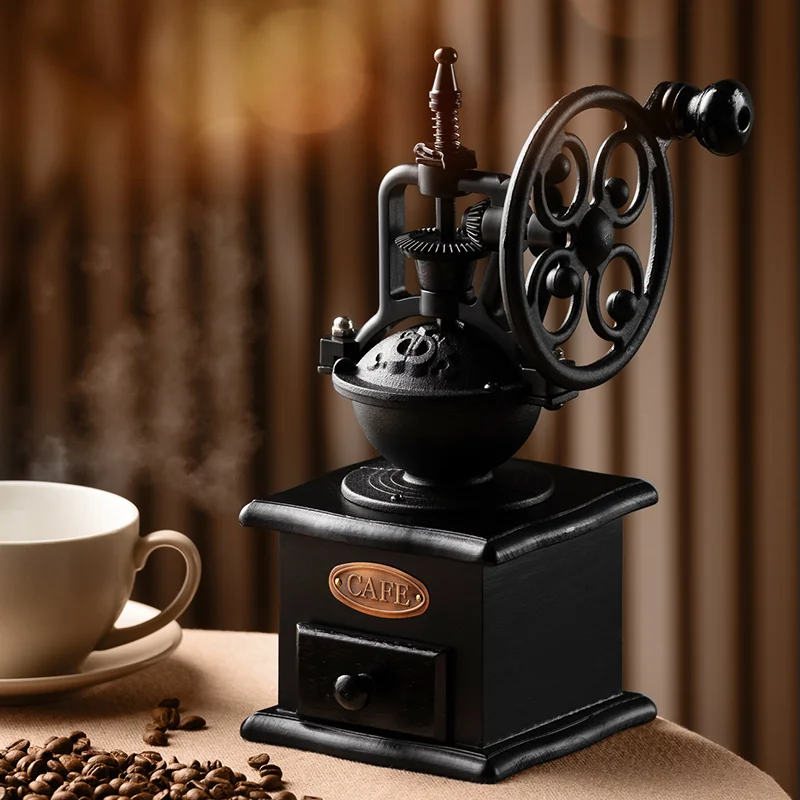
In practical terms, this means you may need to adjust your grinder setting slightly even when switching between beans of the same roast level. The differences are subtle but noticeable to discerning palates.
For the most consistent results, consider:
1. Using beans within 2-3 weeks of their roast date
2. Allowing very fresh beans (1-3 days off roast) to degas slightly before grinding
3. Adjusting grind settings when changing between light and dark roasts
4. Cleaning your grinder more frequently when using especially oily beans
Different bean types may perform better with specific grinder designs. Exploring manual coffee bean grinders with various burr geometries can help you find the perfect match for your preferred coffee origins and roast styles.
Can You Improve a Budget Grinder’s Consistency?
While premium grinders offer superior consistency, budget-friendly models can be significantly improved with some strategic modifications and techniques:
Setting Realistic Expectations
Budget grinders have inherent limitations:
– They’ll never match ultra-premium models for espresso consistency
– They can often be improved to perform adequately for pour-over and drip
– The goal is maximizing performance within physical constraints
Effective Modifications
Several simple changes can improve consistency:
– Burr alignment correction: Use thin adhesive tape to shim burrs for better alignment
– Bearing stabilization: Add food-safe lubricant to bearings to reduce wobble
– Handle reinforcement: Secure loose-fitting handles with food-safe adhesive
– Detent smoothing: Gently sand rough adjustment rings for smoother operation
Technique Adaptations
Adjust your grinding approach to compensate for equipment limitations:
– Maintain perfectly vertical orientation throughout grinding
– Use slower, more deliberate cranking with consistent pressure
– Consider the “pulse grinding” technique—short bursts with brief pauses
– Add beans in smaller amounts rather than filling the hopper
When to Upgrade vs. Modify
Use these guidelines to determine your approach:
– If your grinder produces acceptable results for your brewing method with minor inconsistency, modifications may be sufficient
– If you’re primarily brewing methods that demand high consistency (espresso, pour-over), upgrading provides better returns than extensive modifications
– Consider upgrading when the time invested in working around limitations exceeds the value of your brewing experience
For those looking to maximize value without breaking the bank, manual coffee grinders for espresso offer budget-friendly options that still provide acceptable consistency for demanding brewing methods.
Measuring Success: How to Evaluate Your Grind Consistency Improvements
After implementing changes to your grinder or technique, objective assessment helps determine whether you’ve actually improved consistency:
The Paper Test
A simple visual method to check particle distribution:
1. Grind your typical amount of coffee
2. Spread the grounds thinly on dark-colored paper
3. Take a well-lit photo
4. Compare before/after photos to assess visible fines and boulders
The Extraction Test
Use brewing results as your ultimate benchmark:
1. Brew coffee using your standard recipe
2. Note extraction time (for methods like espresso and pour-over)
3. More consistent grounds typically result in:
– More predictable extraction times
– Smoother flavor profile
– Less astringency and fewer harsh notes
– Better clarity of distinctive flavor notes
The Sieve Analysis
For more quantitative assessment:
1. Grind a measured amount of coffee (e.g., 20 grams)
2. Use a fine mesh strainer or coffee-specific sieves
3. Separate and weigh the different size fractions
4. Calculate the percentage of each size category
5. Lower percentages of outlier sizes indicate improved consistency
When evaluating improvements, focus on these indicators of success:
– Reduced sediment in your cup (especially for French press and immersion methods)
– More even extraction visible in espresso (no channeling or spurting)
– Clearer flavor separation between distinct taste notes
– More consistent brewing times from batch to batch
– Reduced bitterness without increasing sourness
The journey to achieving perfect grind consistency is ongoing, with each small improvement contributing to better coffee quality. Track your progress over time through tastings and visual assessments to confirm you’re moving in the right direction.
Beyond Grinding: Other Factors That Impact Your Coffee Quality
While grind consistency is crucial, it’s just one element in a comprehensive approach to great coffee:
Water Quality
The brewing medium dramatically affects extraction:
– Mineral content: Aim for 75-150 ppm total dissolved solids (TDS)
– Hardness: Look for moderately hard water (2-5 grains of hardness)
– Filtration: Consider specialized coffee water filters rather than standard filters
– Temperature stability: Consistent brewing temperature (195-205°F/90-96°C) is as important as consistent grind
Bean Freshness and Storage
Preserve coffee quality through proper handling:
– Store beans in airtight containers away from light, heat, and moisture
– For best flavor, use beans within 2-4 weeks of roast date
– Consider freezing small portions of very fresh beans for longer-term storage
– Always grind immediately before brewing for optimal results
Brewing Precision
Consistency extends beyond grinding:
– Use a scale to measure coffee and water precisely
– Maintain consistent brewing temperatures
– Control brewing time within 5-10 second tolerances
– Develop a repeatable pouring pattern for methods like pour-over
Equipment Maintenance
Regular cleaning of all brewing equipment:
– Remove coffee oils from brewers weekly
– Descale equipment monthly if you have hard water
– Replace filters as recommended by manufacturers
– Check water temperature accuracy periodically
While achieving perfect grind consistency should remain a primary focus, these complementary factors work together to elevate your coffee experience. The best grinder in the world can’t compensate for poor water quality or stale beans.
At Savor Suite, we understand that exceptional coffee requires attention to each step of the brewing process. Our focus on premium manual grinders reflects our belief that hand grinding offers unparalleled control and connection to the coffee-making process. When you combine quality equipment with knowledge and technique, you transform a simple beverage into a daily ritual worth savoring.

